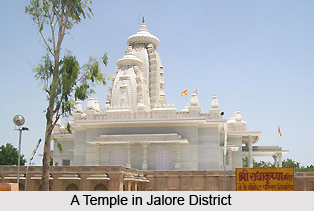 Jalore is located 160 kilometers north of Mount Abu. It was a principality of the Rathores of Marwar. The fortified hill citadel, though in ruins, encloses Muslim, Hindu and Jain shrines. The mosque built by Alauddin Khilji with scores of domes in different sizes and shapes is of special interest. The surrounding villages constitute the heart of equestrian Rajasthan. There are numerous local attractions here. These can be categorized into historical and religious places. One of the major places of interest in Jalore is the Sundha Mata Temple.
Jalore is located 160 kilometers north of Mount Abu. It was a principality of the Rathores of Marwar. The fortified hill citadel, though in ruins, encloses Muslim, Hindu and Jain shrines. The mosque built by Alauddin Khilji with scores of domes in different sizes and shapes is of special interest. The surrounding villages constitute the heart of equestrian Rajasthan. There are numerous local attractions here. These can be categorized into historical and religious places. One of the major places of interest in Jalore is the Sundha Mata Temple.
The temple is dedicated to Goddess Chamunda. The devotees throng the temple premises throughout the year. The holy shrine has been constructed in pristine white marble. The pillars here will remind the travelers of the Dilwara Temple in Mount Abu. An amazing fact about this religious place is that only the head of the goddess is worshipped here. Besides the main idol the images of Lord Shiva, Goddess Parvati and Ganesha are also to be found at Sundha Mata Temple. Other religious places in Jalore include Pataleshwar Temple, Jagannath Mahadev, NeelKanth Mahadev and Sire Temple. What is noticeable about these religious places is the predominance of Shiva temples. The lord is worshipped in various forms here.
Besides the Hindu temples Jain shrines are scattered throughout the district of Jalore. The Jain temples here are Jain Pilgrim Bhandarpur, Bawan Jinalaya Jain Temple, Jain Temple at Bakra Road, Nadishwar Deep Tirth and the Ship Temple. These temples are dedicated to several Jain Tirthankaras. As is the case with Jain temples their superb architecture makes them interesting to the travelers. Mostly made of stone or marble they are architectural delights.
The historical places are also in abundance at Jalore. Jalore Fort, TopKhana, Fort of Kot Kastha, Fort of Bhadrajun and Lohangadh of Jaswantpura are some of the interesting places to check out. Jalore Fort is the foremost historical place in this city. Situated at 1200 feet on the mountaintop it tells the story of heroism and might. Within the fort the temples (both Hindu and Jain) and the Palace of Man Singh are worth checking out. During the British rule this fort was used by them to fight the revolutionists.
The Topkhana was the place where artilleries were kept. This building is beautifully carved out of stone. Though incomplete for some unknown reasons it is worth a visit. The flora and fauna in the surrounding areas of Jalore will enable the travelers to check out the wildlife here.
Also known as the Granite City of Rajasthan Jalore has evolved into a popular tourist attraction. Its accessibility from the adjacent Rajasthani regions has also added to its fame.



















